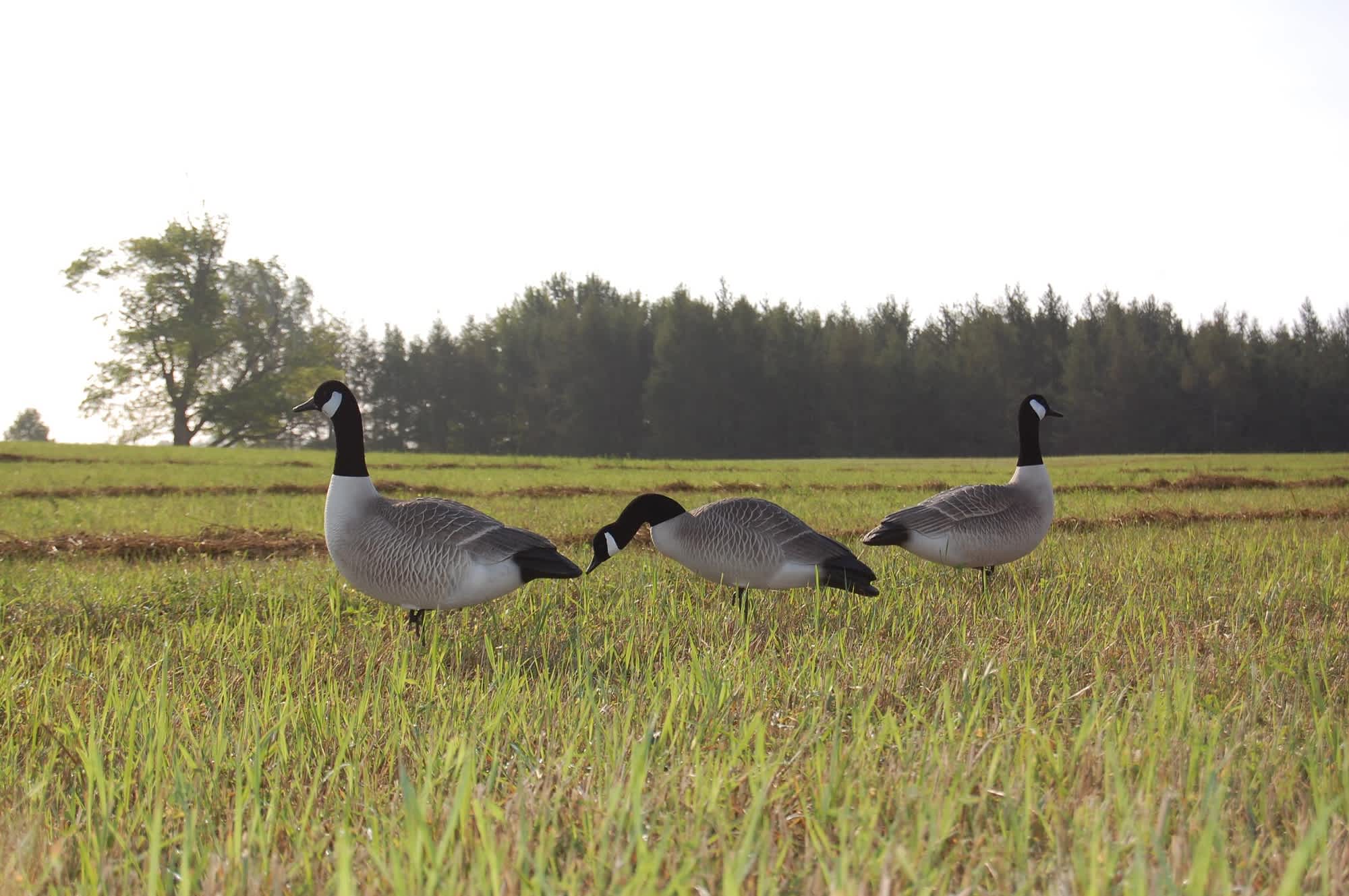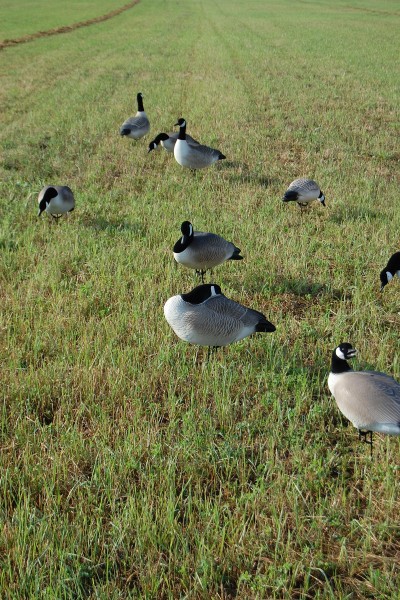Picking the Right Decoy Spread
Hard Core Decoys 09.12.13

The sky has turned from midnight blue to shades of bright purple and yellow. The crows are flying and you can hear the roosters on the farm down the road chiming in that morning has finally arrived. You snuggle down in your Hard Core Man Cave blind, knowing that it is almost here.
Then you hear it. The first ringing honks and clucks in the distance. The geese are on the wing and headed your way. The Hard Core Full-body Canada Goose Decoys are twitching in the breeze and look awesome. This is why you went Hard Core in the first place.
The birds are responding to your calls and come in for the perfect finish. The call goes out to “Take ‘em!” Blinds open, barrels go up, and birds rain down. It was perfect.
Want to make for perfect mornings like this on your own? Besides going with the perfect set up of decoys, blinds, clothing, and other gear, there are a few things you need to do. Having the right decoy spread is a vital part of getting birds to finish and there are lots of options.
Spread ‘em
The purpose of having the right spread is pretty easy to determine. You want the birds to finish and come in where you want them to. It sounds easy enough, but it’s not. Spreads have to not only funnel the birds right to you, but they have to look right to the birds. That is where things get tricky.
The best decoys in the world won’t work if the birds get spooked by something not looking right. How do you combat this? The best place to start is looking at live birds. When you’re scouting, see how the birds are sitting, be it in a field or on water. Callers always give the advice of listening to live birds and seeing how they vocalize for different occasions. The same goes for seeing how they spread out when they come in. And what works in one area may not work in another. Remember, as the birds migrate south, they get shot at a lot and they have different needs.
Let’s look at a few basic rules. Birds, as with any other animal, generally don’t want to get eaten. I know, sounds crazy right? But in all seriousness, you’re not going to get birds to come into a situation that doesn’t look safe and inviting. Make sure you don’t have your spread set up in areas that look like they are full of nasty predators just waiting to pounce. Unfortunately this can include where and how you set up your blind. That’s another reason why brushing in your blind is so important.
Another important thing about your spread is the placement of the different types of decoys. If you’ve ever wondered why there are some many different body and head positions available for decoys, well, just look at those live birds. What you want to do is create a relaxed-looking atmosphere for the birds to land in. Having the right mix of feeders and sentries is important. But there are other positions to consider. Sleepers and resters being in the mix is a good thing. For the early morning hunts, I don’t like to use many sleepers. When I usually hunt, there are no birds sleeping in the field in the early mornings. Having a pile of them out would look unnatural.
I once loaned my decoys to a newbie. He only needed a few, he said. I would have taken him out that morning, but I had a prior commitment. I showed up at the end of his hunt to see how he did, knowing that birds were in the area. His report was that birds would come in but wouldn’t finish and he’d never gotten a shot. The problem: he only used my sentry decoys. He went with a smaller spread, so he just grabbed a few bags. He thought the sentries looked better, so he set out a full spread of them. When he said that the birds came in, took one look and kept going, I told him that it was no wonder. Would you want to land in a place where it looked like trouble?

What works?
Here’s some tips on favorite spreads from some of the Hard Core crew.
“My favorite spread would be hunting some sheet water in a big open field with ideal concealment,” said Matt Dahlstrom. “Birds seem to finish better to water for some reason. Using some goose and duck floaters in the water along with some full-bodies spread throughout the field and water. I like to use resters and sleepers along the edge of the water to resemble loafing birds.”
Matt added that concealing your blinds as best as possible is a key part of any spread, as you’re basically part of the spread!
Hard Core’s Randy Hill added that location and scouting make up for a lot of mistakes when it comes to decoys.
“I’m not worried about the spread too much on opening day of the season if I’m where the geese are, but that’s on opening day,” he said. “After a couple days of hunting, now that is when I start concentrating on the way I set up the spread more. Hunting educated birds gets a lot tougher and you need to have a realistic looking spread of decoys.”
Mike Galloway said setting the spread totally depends on the wind.
“In a perfect world, I like a horseshoe spread, but I also like to have the geese set up in family groups,” he stated. “If each family group represents a dot and you connected the dots, it would look like a horse shoe.”
Jason Summers, a flyway manager for Hard Core’s Pro Staff, often uses a typical J-hook pattern.
“We hunt a lot of tree rows and edges of fields,” he said. “It keeps the birds close into shooting range, and it also keeps them from landing too far out. Sometimes, if the birds don’t like what we have set up, we’ll just set up a weird spread but leave a pocket and opening downwind.”
Having the ability to change your layout on the fly is a key thing. I often set up in an inverted Y-shaped pattern, with the longer trailing arm of the “Y” heading into the wind. This sets up the main finishing area in the fork, with my blinds set at the bottom. If the birds come in to either side of the “Y,” I still have a shot, as I set the furthest decoy at the maximum range I’ll shoot.
The traditional pattern is an “X” shape. That is what I first learned to set decoys in, with the hunters being in the center of the blind. Does it work? Sure. But does it look natural? That I’m not convinced of, and like I said, looking natural means a lot more than anything else.
When hunting specks, Hard Core Pro Staff Flyway Manager Scott Roduner says realism means more than anything else.
“Out here in California, the specks won’t come in if there is a blade of grass out of place,” he said. “You have to have the best decoys you can get, and don’t do anything that gives the birds something to look at for a while. Spreads don’t mater as much because they want to land away from other birds. If they do land, it’s always five to 10 yards away from the decoys.”
Because of the skittish nature of the birds, Roduner said he sets his blinds 20 to 40 yards in front of the decoys.
“The way I set up, and the way I’m successful, is by having the birds finishing right over my head.”
Spreads are different for every hunter. What have you done that has worked for you? Let us know on our Facebook and Twitter pages and be sure to check in for the latest news and contests!

